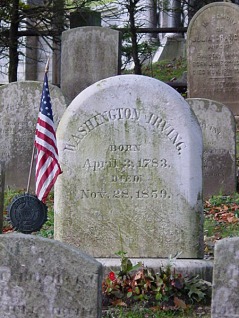Returning from Spain in 1846, Irving took up permanent residence at Sunnyside, still under renovation, but jammed with family and an endless stream of guests, visitors, and sightseers. Apart from maintaining reams of regular correspondence, he was working again, poking at a long-considered biography of George Washington, reworking a sketch of Oliver Goldsmith for a new book, and polishing the Mahomet biography he had angrily yanked away from John Murray in 1831. He was also hard at work on the Author’s Revised Edition of his works for Putnam, in a deal that guaranteed him 12 percent of the retail price of all copies sold—an agreement that would earn him nearly $88,000 over the next 12 years, the equivalent of $2 million today.
He would make another tidy sum of money when John Jacob Astor died in 1848. Irving was hired as an executor of Astor’s will, netting $10,600 for his efforts, about $245,000 today. “What an instinct that man has for gold!” writer James Fenimore Cooper exploded. Fittingly, Irving would also be selected as chairman of the Cooper memorial held after the writer’s own death in 1851. And he would do so for free.

Irving at home at Sunnyside, as sketched by Charles Martin in 1851.
Apart from Cooper’s sneering, the tributes continued to roll in. “There is no name,” said the Southern Quarterly Review, “in the youthful history of our country, which does, or should, occupy a higher place than that of Washington Irving.”
The Review was nearly correct—but there was one person who occupied an even higher place in the country’s history. Irving himself knew it, and he intended to pay tribute to that person the only way he knew how. Gathering 25 years of notes about him, he was ready at last to begin working seriously on his biography of George Washington.
He became a regular at Mount Vernon and Washington, DC, digging through archives or walking the same grounds as the first president. During these trips, he became friends with President Millard Fillmore and then with his successor, Franklin Pierce, who delighted Irving when he informed him that that he would give a consular post to Irving’s friend Nathaniel Hawthorne.
He continued to socialize actively and keep up with his correspondence—but he was now 70 years old, and such activities were taking their toll. In August 1853, after recovering from a serious illness, he prepared a family plot in Sleepy Hollow cemetery.
Illness kept him from his pen at increasingly longer intervals, as did injuries sustained when he was thrown from a horse. On the mend, he collected articles he had written for Knickerbocker magazine and published them as Wolfert’s Roost in 1855 to enormous success. Reconciled with Van Buren, he visited the retired President in his Kinderhook mansion—coincidentally, the same mansion in which Irving had written A History of New York a lifetime ago.

Washington Irving’s grave, in Sleepy Hollow Cemetery.
His health was deteriorating rapidly, and work on the final volume of Washington continued slowly. In March 1859, it was finished. Irving sagged, relieved; his health was failing. Sleeping and breathing came with difficulty now.
On the evening of November 28, 1859, only eight months after completing his final book, Washington Irving died of a heart attack in his bedroom at Sunnyside. He was 76 years old.
Washington Irving was buried at Sleepy Hollow cemetery on December 1, 1859. There is no epitaph; Irving has left it to you to determine his legacy.
Minister (1842-1846) | Icon (1846-1859) | Back to Washington Irving

Greatt post
LikeLike